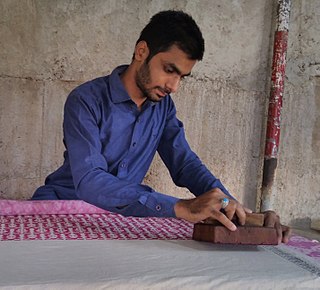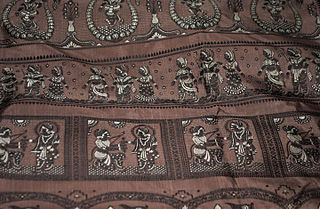
Khadi, derived from khaddar, is a hand-spun and woven natural fibre cloth promoted by Mahatma Gandhi as swadeshi (self-sufficiency) for the freedom struggle of the Indian subcontinent, and the term is used throughout India, Pakistan and Bangladesh. The first piece of the hand-woven cloth was manufactured in the Sabarmati Ashram during 1917–18. The coarseness of the cloth led Gandhi to call it khadi. The cloth is made from cotton, but it may also include silk or wool, which are all spun into yarn on a charkha. It is a versatile fabric that remains cool in summer and warm in winter. To improve its appearance, khadi is sometimes starched to give it a stiffer feel. It is widely accepted in various fashion circles.

The Khadi and Village Industries Commission (KVIC) is a statutory body formed in April 1957 by the Government of India, under the Act of Parliament, 'Khadi and Village Industries Commission Act of 1956'. It is an apex organisation under the Ministry of Micro, Small and Medium Enterprises, with regard to khadi and village industries within India, which seeks to - "plan, promote, facilitate, organise and assist in the establishment and development of khadi and village industries in the rural areas in coordination with other agencies engaged in rural development wherever necessary.".

Phulkari refers to the folk embroidery of the Punjab. Although Phulkari means floral work, the designs include not only flowers but also cover motifs and geometrical shapes. The main characteristics of Phulkari embroidery are use of darn stitch on the wrong side of coarse cotton cloth with coloured silken thread. Punjabi women create innumerable alluring and interesting designs and patterns by their skilful manipulation of the darn stitch. According to Kehal (2009), a cloth where only a few flowers are embroidered is called a Phulkari. The other types are distinct varieties. The traditional varieties of Phulkaris are large items of cloth and include Chope, Tilpatr, Neelak and Bagh. Sometimes, the Bagh is given separate categorization of its own as on other varieties of a Phulkari, parts of the cloth is visible, whereas in a Bagh, the embroidery covers the entire garment so that the base cloth is not visible. Further, in contemporary modern designs, simple and sparsely embroidered dupattas, odhinis, and shawls, made for everyday use, are referred to as phulkaris, whereas clothing items that cover the entire body, made for special and ceremonial occasions such as weddings are called baghs. The Phulkari continues to be an integral part of Punjabi weddings to the present day.
Assam silk denotes the three major types of indigenous wild silks produced in Assam—golden muga, white pat and warm eri silk. The Assam silk industry, now centered in Sualkuchi, is a labor-intensive industry.

The Ministry of Textiles is an Indian government national agency responsible for the formulation of policy, planning, development, export promotion and regulation of the textile industry in India. This includes all natural, artificial, and cellulosic fibers that go into the making of textiles, clothing and Handicrafts.

Tussar silk is produced from larvae of several species of silkworms belonging to the moth genus Antheraea, including A. assamensis, A. paphia, A. pernyi, A. roylei, and A. yamamai. These silkworms live in the wild forests in trees belonging to Terminalia species and Shorea robusta, as well as other food plants such as jamun and oak found in South Asia, eating the leaves of the trees on which they live. Tussar silk is valued for its rich texture and natural, deep-gold colour, and varieties are produced in many countries, including China, India, Japan, and Sri Lanka.
Weaving and cloth trading communities of Western India particularly of Gujarat are called Vankar/Wankar/Vaniya. The four major woven fabrics produced by these communities are cotton, silk, khadi and linen. Today majority of these community members are not engaged in their ancestral weaving occupation still some population of these community contribute themselves in traditional handloom weaving of famous Patola of Patan, Kachchh shawl of Bhujodi in Kutch, Gharchola and Crotchet of Jamnagar, Zari of Surat, Mashroo of Patan and Mandvi in Kutch, Bandhani of Jamnagar, Anjar and Bhuj, Motif, Leheria, Dhamakda and Ajrak, Nagri sari, Tangaliya Shawl, Dhurrie, Kediyu, Heer Bharat, Abhala, Phento and art of Gudri. Vankar is described as a caste as well as a community.

The Tamil Nadu Handloom Weavers' Cooperative Society, popularly known as Co-optex, is a cooperative of traditional handloom weavers of the Indian state of Tamil Nadu. This is under the control of Department of Handlooms, Handicrafts, Textiles and Khadi of Government of Tamil Nadu. The organisation owns a number of shopping outlets in Tamil Nadu. Co-Optex also has an international arm, Co-optex International which exports its products to Germany, France, Netherlands, Belgium, Spain, Switzerland, Canada, Greece, Hong Kong, U.K. South Africa and the U.A.E.

The crafts of India are diverse, rich in history, culture and religion. The craft of each state in India reflect the influence of different empires. Throughout centuries, crafts have been embedded as a culture and tradition within rural communities.

Baluchari Sari is a type of sari, a garment worn by women in Bangladesh and Indian states of West Bengal, Tripura and Assam. This particular type of sari originated in West Bengal and is known for depictions of mythological scenes on the anchal of the sari. It used to be produced in Murshidabad but presently Bishnupur and its surrounding areas of West Bengal are the only place where authentic Baluchari saris are produced. It takes approximately one week to produce one such sari. In 2011, the Baluchari Sari was granted the status of Geographical Indication for West Bengal in India.
Gujarat State Handloom and Handicrafts Development Corporation Ltd is an agency of Government of Gujarat established in 1973 with the main objective of identification, revival, development of handicrafts and handlooms of Gujarat.The Corporation markets products of artisans through its Garvi-Gurjari chain of emporiums in India and supply to exporters.

Kailash Chandra Meher is an Indian artist, inventor, and social activist. He is a painter of contemporary modern art paintings and traditional Tussar Pattachitra paintings of Odisha. He was a recipient of the Padma Shri by the Government of India in 2013.
Dhirendra Kumar is an Indian Forest Service Officer of 1983 batch. Born on 22 December 1954, he was a former Special Secretary, Industry Department cum Director of Sericulture, Handloom and Handicraft, Government of Jharkhand and Managing Director of Jharkhand Silk Textile and Handicraft Development Corporation (Jharcraft) Before Joining to the forest services, he did his Post Graduation in Geology from Ranchi University and then served as lecturer at St. Xavier’s College, Ranchi.
The National Cooperative Development Corporation (NCDC) is a statutory Corporation set up under an Act of Indian Parliament on 13 March 1963. The objectives of NCDC are planning and promoting programmes for production, processing, marketing, storage, export and import of agricultural produce, foodstuffs, industrial goods, livestock and certain other notified commodities and services on cooperative principles and for matters concerned therewith or incidental thereto.
Jasleen Dhamija (1933-2023) was an Indian textile art historian, crafts expert and former UN worker. Based in Delhi, she was best known for her pioneering research on the handloom and handicraft industry, especially history of textiles and costumes. She was professor of living cultural traditions at the University of Minnesota. Over the years, during her career as a textile revivalist and scholar, she authored several books on textiles, including Sacred Textiles of India (2014).
Laila Tyabji is an Indian social worker, designer, writer, and craft activist. She is one of the founders of Dastkar, a Delhi-based non governmental organization, working for the revival of traditional crafts in India. She was honored by the Government of India in 2012 with the Indian civilian award of Padma Shri. She is the daughter of late Badruddin Tyabji, ICS, who was a senior Indian civil servant and diplomat.

Handloom saris are a traditional textile art of Bangladesh and India. The production of handloom saris is important for economic development in rural India.
Kotpad Handloom is a vegetable-dyed fabric woven by the tribal weavers of the Mirgan community of Kotpad village in Koraput district, Odisha, India. Cotton sarees with solid border and Pata Anchal, duppatta with typical Buties / motifs, Scolrfs on cotton, silk, handloom stoles, and dress materials are all dyed with organic dyes. The natural dye is manufactured from the aul tree grown in this area. The Kotpad tussar silk saree with tribal art and Kotpad handloom fabrics with natural color is its specialty.
Suraiya Hasan Bose was an Indian textile conservator, textile designer, and manufacturer, who worked to preserve traditional Indian textile art and techniques. She worked with the Indian Cottage Industries Emporium, as well as the Indian Handloom and Handicrafts Export Corporation, later establishing her own textile manufacturing unit to create traditional Indian textiles. Her designs have been exhibited in the Victoria and Albert Museum.
The All India Handicrafts Board (AIHB), was an organisation in India established in 1952, which aimed to advise the Ministry of Textiles on development programmes for handicrafts. Its early key figures included Pupul Jayakar, Kamaladevi Chattopadhyay, Lakshmi Chand Jain and Fori Nehru. It was abolished by the Government of India in 2020 during the COVID-19 pandemic.









